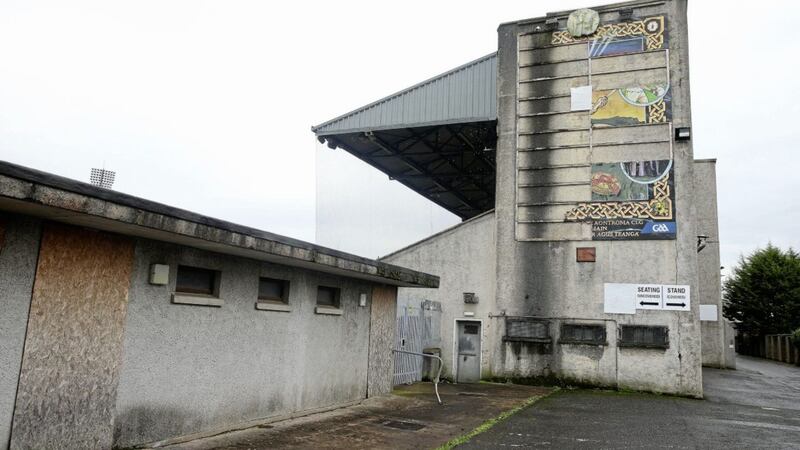OVER the past weekend I came across a supplement which marked the 50th anniversary of Casement Park.
Published by the Andersonstown News in 2003, it was compiled by my dad and I'm glad I still have a copy of it to hold onto. Interspersed among the old photos and fond recollections is the story behind the development of Casement Park, and it makes for fascinating reading.
Antrim hurlers made it to the All-Ireland final in 1943, beating the giants of Galway and Kilkenny on the way. Hopes were high, but those earlier victories had come at Corrigan Park on the Whiterock Road in Belfast, home to club side St John's. The final was, of course, in Croke Park, where Antrim were destroyed 5-16 to 0-4 by Cork.
The County Board identified the playing surface at Corrigan Park as the problem. It was deemed to be a ‘slow surface’ as opposed to the fast field of Croke Park. The Board embarked on a fund-raising drive to renovate the playing surface of Corrigan, and with remarkable foresight sought out available land with the extra money raised to build a new county ground.
The site of what is now Casement Park was, at that time, the end of the city/county boundary. The field which would become the iconic Casement was adjacent to very few houses and was the turning point for the bus route, Casement the final stop in the city.
Through bazaars, challenge games, even exhibition boxing matches, but most significantly through a locally organised weekly pools subscription, there was sufficient funds to buy the land and begin the Casement project. The gates were opened in 1953 to the pride of Gaels throughout west Belfast, the whole city and the county of Antrim. A handful of visionaries and the handiwork of hundreds of volunteers had made it happen.
Of course, Casement Park was closed in 2012 in anticipation of a successful planning application and the work beginning on a modern new stadium. Sadly that work has not yet started, and as we enter 2018 the best hope is that, with no further significant delays, the new Casement will be open by 2021, almost a decade after the gates were pulled shut.
Anyone who manages to sneak a peak at the state of the stadium now could be reduced to tears when recalling famous days standing on the bank, sitting in the stand or, even better, playing on that fast surface.
I was fortunate enough to play there a few times with my club St Agnes, a team drawn from the area immediately surrounding Casement. It is probably even true that visits to Casement, as a player, spectator or official, came to be taken for granted. If and when the new stadium gets built that won't happen again.
In the continued absence of an Executive and a minister at the head of the Department for Infrastructure, it may well fall to the permanent secretary of the Department to make a decision on the planning application. A local minister may have moved things along at greater pace and I have little doubt that a suspended Assembly and lack of local ministers has slowed down the Casement project, as it has many other key decisions and policy development.
Civil servants are bound to maintain, as far as practical, the policy guidelines set down by the last politically accountable Government. The longer we get though from January 2017, when the Assembly was dissolved, the less practical this becomes. Policies do lose relevance over time and need to be updated, that is the role of ministers and an Assembly.
This halfway house in which we now operate serves no one, not the business community, those on hospital waiting lists or trolleys, wider society and not even the civil servants who would prefer to operate under political guidance, a point well made by David Sterling last Friday.
Northern Ireland faces a number of major infrastructure decisions which could have a positive impact on our economy, not to mention the navigation required through the wreckage of the Brexit vote and its implications.
The electricity interconnector, the York Street Interchange, major proposals for significant new wind-farms, a new medical school in the north west and, yes, I would put Casement Park in there too.
As the two main parties slug it out, hope for a restored devolution is slowly but surely slipping away and that will increase the demand for or at least acceptance of direct rule ministers making decisions with guidance from the civil servants - although it is questionable whether west Belfast Gaels would have too much faith in a Tory minister prioritising Casement Park.
Those who value local accountability and the political structures which provide them really should take that on board as they dig their heels in on red lines and preconditions.
We know the phrase ‘build it and they will come.’ Although it is a misquote from the baseball movie Field of Dreams, the sentiment holds true. Look at what the visionaries in Antrim achieved in the 1940s and early 1950s.
We now need the same kind of leadership and vision in our politics. It's time to move to a new faster playing surface.
:: Brendan Mulgrew (brendan.mulgrew@mwadvocate.com) is managing partner at MW Advocate (www.mwadvocate.com)
:: Next week: Conor Lambe








